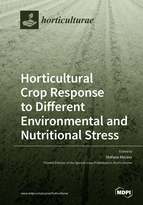Horticultural Crop Response to Different Environmental and Nutritional Stress
A special issue of Horticulturae (ISSN 2311-7524). This special issue belongs to the section "Plant Nutrition".
Deadline for manuscript submissions: closed (25 April 2021) | Viewed by 46030
Special Issue Editor
Interests: agronomy; precision agriculture; crop yield; fertilization; irrigation; remote sensing; horticultural crops; vegetation indices
Special Issues, Collections and Topics in MDPI journals
Special Issue Information
Dear Colleagues,
Environmental conditions and nutritional stress may greatly affect crop performance.
Abiotic stresses such as temperature (cold, heat), water (drought, flooding), irradiance, salinity, nutrients, and heavy metals can strongly affect plant growth dynamics and the yield and quality of horticultural products. Such effects become more and more important in the course of global climate change. Different strategies and techniques can be used to detect, investigate, and mitigate the effects of environmental and nutritional stress. Horticultural crop management is moving toward digitized, precision management through wireless remote-control solutions, but data analysis, although a traditional approach, remains the basis of stress detection and crop management.
This Special Issue intends to summarize the recent progress in agronomic management strategies to detect and reduce environmental and nutritional stress effects on the yield and quality of horticultural crops. Studies focused on these issues are welcome.
Prof. Dr. Stefano Marino
Guest Editor
Manuscript Submission Information
Manuscripts should be submitted online at www.mdpi.com by registering and logging in to this website. Once you are registered, click here to go to the submission form. Manuscripts can be submitted until the deadline. All submissions that pass pre-check are peer-reviewed. Accepted papers will be published continuously in the journal (as soon as accepted) and will be listed together on the special issue website. Research articles, review articles as well as short communications are invited. For planned papers, a title and short abstract (about 100 words) can be sent to the Editorial Office for announcement on this website.
Submitted manuscripts should not have been published previously, nor be under consideration for publication elsewhere (except conference proceedings papers). All manuscripts are thoroughly refereed through a single-blind peer-review process. A guide for authors and other relevant information for submission of manuscripts is available on the Instructions for Authors page. Horticulturae is an international peer-reviewed open access monthly journal published by MDPI.
Please visit the Instructions for Authors page before submitting a manuscript. The Article Processing Charge (APC) for publication in this open access journal is 2200 CHF (Swiss Francs). Submitted papers should be well formatted and use good English. Authors may use MDPI's English editing service prior to publication or during author revisions.
Keywords
- Crop management;
- Abiotic stresses;
- Nutritional stress;
- Irrigation stress;
- Wireless sensor networks;
- Spatial analysis and zoning;
- Variable-rate technologies;
- Proximal and remote sensing of soils and crops.






